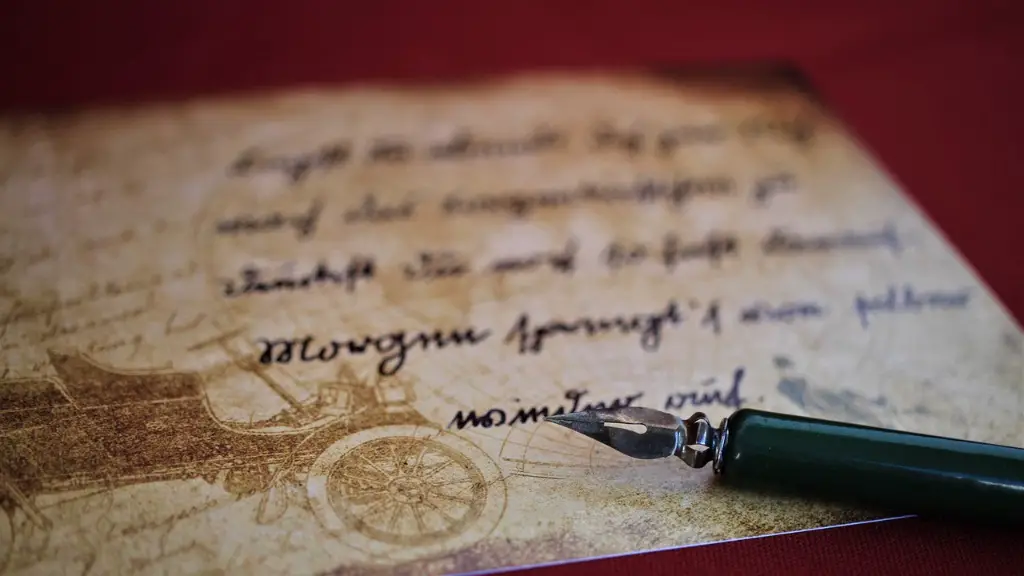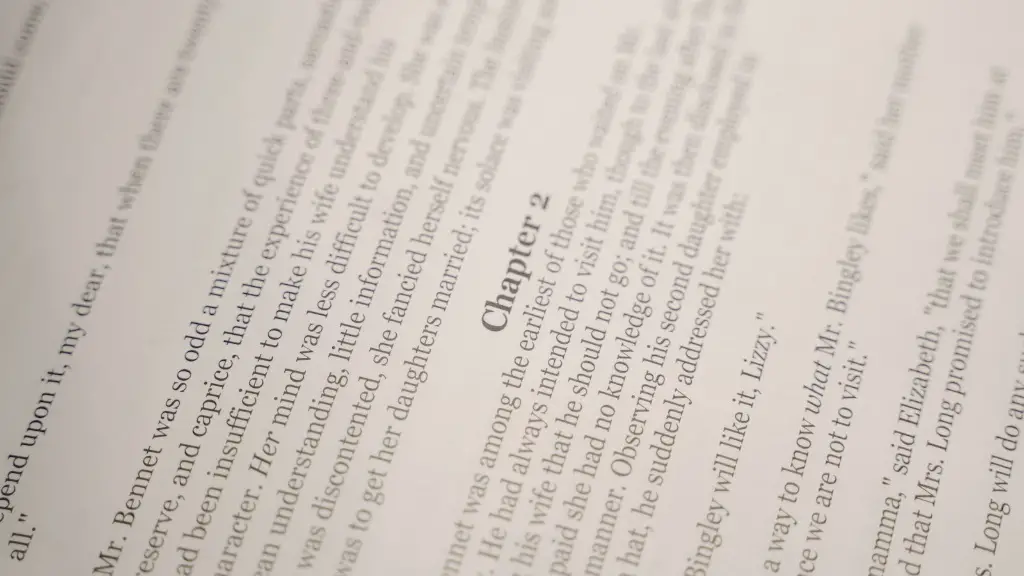Characteristics of Elizabethan Poetry
The era of Elizabethan Poetry (1558 – 1603) is a particularly distinguished period in English literature, due to its significant influence in the development of modern English poetry. The Elizabethan period is known for the distinctive style and remarkable quality of the poetry that was produced and reads today by many people. Elizabethan poetry has some particular characteristics that can be identified and that make it so distinctive and attractive.
One of the main and most frequent elements of Elizabethan poetry is the use of figures of speech and poetic devices. The use of these devices makes the prose beautiful, vivid, lively and engaging, giving the poem a particular rhythm, structure, and a charming sound. For instance, the use of metaphors, alliteration, personification, allusions, metonymy and other figurative language had a great effect on the popularity of the Elizabethan literary works.
The focus of Elizabethan poetry was mainly on emotions. The writers used to express their feelings, thoughts and ideas for matters such as love, loss, sadness, passion, friendship and loyalty, something that can still be seen in many of the poems written during that time. The writers often used extremely powerful and passionate words in their works to express their feelings. In addition, the works of this period had a clear philosophical approach, having Christian values as the main theme.
The Elizabethan poets were also prominent for their delicate attention to detail when writing their works. These writers were capable of depicting a great range of characters and situations, and their descriptive works were filled with intense and captivating scenes. In addition to this, their poems were often written in an elaborate structure, that could blend from one thought to another in a way that created a unity in the story and evoked powerful emotions in the reader.
The Elizabethan period was also a perfect environment for the development of more innovative changes in poetry. During this time, Edmund Spenser, along with other poets and playwrights, developed a poetic innovation known as Spenserian Stanza, which merged the metrics of classical Latin poetry with elements of iambic pentameter and some other specific specs of Renaissance poetry. The Spenserian Stanza poetry was one of the main innovations of Elizabethan poetry and had a great impact in the literary field.
In conclusion, the specific characteristics of Elizabethan poetry made it one of the most distinctive eras in the history of English literature and a remarkable example of the power of poetry and the richness of the English language. Advancements such as the Spenserian Stanza added to the beauty of the works produced in this period and are a clear example of the innovative spirit of the writing of this period.
Other Forms of Poetry from the Elizabethan Period
Apart from the conventional forms of poetry, the Elizabethan period saw the emergence of several other types of poetry. One of them was the Sonnet, which was a short, 14-line poetic form that had a very specific rhyme scheme. This form was very popular during the Elizabethan age and was widely used by many authors. Apart from the Sonnet form, the other popular Elizabethan forms of poetry included the Blank Verse, Chanson de Geste, Ode, Poulter’s Measure, Verse epistle, Elegiac stanza, Hexameter and Rondeau.
One of the most famous examples of Elizabethan poetry was the work of William Shakespeare, who wrote many sonnets and other poems in different forms. While many unknown authors of the period wrote in some of the forms mentioned above, the Sonnets were particularly popular for the beauty and complexity of their writing.
The development of the different types of poetry from this period opened a new range of possibilities for writers and helped to spread the admiration of poetry all over the world. These types of poetry survived during the centuries following the Elizabethan Age and helped shape the development of modern poetry.
Metrics of Elizabethan Poetry
The metrics of Elizabethan poetry was mainly based on a combination of iambic pentameter and the classical Latin poetry metric systems. Iambic pentameter was the main poetic form used in this period, and it refers to the combination of five metrical feet within a line of poetry. This type of metric was characterised by an alternating pattern of stressed and unstressed syllables, with one foot consisting of one stressed syllable and one unstressed one. This particular pattern has been used in countless works of literature and is still used today in many pieces of poetry.
The use of classical Latin metric structures were also very important for Elizabethan poetry. This system was mainly used for longer poems andbased mainly in the use of quantitative verse. This included poems that had a combination of syllables and long and short syllable patterns. This type of metric was popular and present in many of the epic poems written during the Elizabethan period, often merged with elements of iambic pentameter and Spenserian Stanza forms.
The combination of these two meters gave the Elizabethan poems a unique sound and rhythm that they are known and admired for, enriching many of the most complex and beautiful works of this period. The incorporation of elements of both classical and modern metric systems was part of the innovation of the Elizabethan literature, helping it to stand out in comparison to other works of literature.
Audience Engagement Levels of Elizabethan Poetry
The audience engagement level of Elizabethan poetry was notably higher than in other forms of literature from the same era. This huge engagement, mainly due to the vividness and intense emotions of the poetry, made the writing of this period very popular in theatres and public readings. During this period, many public readings and theatrical performances helped to spread the fame of many Elizabethan poets and their works.
The readable and accessible form of Elizabethan poetry helped to make it even more popular than other forms of literature. The combination of vivid descriptions, philosophical approaches and the use of different poetic devices were elements that engaged the audience and contributed immensely to the popularity of the works. The intense feelings invoked by the poetry made Elizabethan poetry an enjoyable and engaging reading experience.
The vividness and emotion of Elizabethan poetry and its accessible form also made it popular with readers of all ages. This poetry appealed to children, young adults and adults, as it had the capacity to evoke strong and powerful emotions in the readers. The mixing of this emotion with the complexity of the philosophical themes of the works was an attractive element and a key factor in the immortality of the Elizabethan literary works.
Translating Elizabethan Poetry
The translators of Elizabethan poetry faced several challenges when translating this type of literature. The main challenge was the combination of the classic metric structures and poetic devices used in the original writing. This complex combination made it difficult to maintain the original structure and rhythm of the poem when it was done in another language. The special characteristics of the English language, including the alliteration, stressed and unstressed syllables, and the specific linguistic features, were difficult to replicate.
In addition, the complex structures of many of the Elizabethan poems required some changes and simplifications to English metrical structures when they were translated. This usually involved a slightly different semantic approach or a change in the length and structure of some words.
The philosophy and religious topics used in the poetic works of this period also had to be taken into consideration when translating them. Translating the works of this period was a difficult but enjoyable experience, as translators discovered the beauty and the power of Elizabethan poetry.
Conclusion of Elizabethan Poetry
The effect of Elizabethan poetry on modern literature is indubitable, as it set a precedent for many of the subsequent works of literature. The unique combination of metric structures, poetic devices and vivid emotions give Elizabethan poetry a special and unique sound that makes it immortal. The innovative spirit and the captivating elements of the works of this period still appeal to poetry readers today, which is a clear testament of the beauty of Elizabethan poetry.




